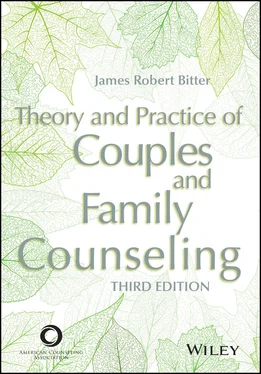James Robert Bitter - Theory and Practice of Couples and Family Counseling
Здесь есть возможность читать онлайн «James Robert Bitter - Theory and Practice of Couples and Family Counseling» — ознакомительный отрывок электронной книги совершенно бесплатно, а после прочтения отрывка купить полную версию. В некоторых случаях можно слушать аудио, скачать через торрент в формате fb2 и присутствует краткое содержание. Жанр: unrecognised, на английском языке. Описание произведения, (предисловие) а так же отзывы посетителей доступны на портале библиотеки ЛибКат.
- Название:Theory and Practice of Couples and Family Counseling
- Автор:
- Жанр:
- Год:неизвестен
- ISBN:нет данных
- Рейтинг книги:5 / 5. Голосов: 1
-
Избранное:Добавить в избранное
- Отзывы:
-
Ваша оценка:
- 100
- 1
- 2
- 3
- 4
- 5
Theory and Practice of Couples and Family Counseling: краткое содержание, описание и аннотация
Предлагаем к чтению аннотацию, описание, краткое содержание или предисловие (зависит от того, что написал сам автор книги «Theory and Practice of Couples and Family Counseling»). Если вы не нашли необходимую информацию о книге — напишите в комментариях, мы постараемся отыскать её.
Theory and Practice of Couples and Family Counseling — читать онлайн ознакомительный отрывок
Ниже представлен текст книги, разбитый по страницам. Система сохранения места последней прочитанной страницы, позволяет с удобством читать онлайн бесплатно книгу «Theory and Practice of Couples and Family Counseling», без необходимости каждый раз заново искать на чём Вы остановились. Поставьте закладку, и сможете в любой момент перейти на страницу, на которой закончили чтение.
Интервал:
Закладка:
Ethical Decision-Making
Understanding principles and virtues alone does not resolve an ethical dilemma. Some process is necessary that uses these principles and virtues. What follow are descriptions of three models of ethical decision-making related to the three ethics models we have already presented. These three models do not represent all available models of ethical decision-making. They are simply used to demonstrate how different perspectives might be applied.
Models of Ethical Decision-Making
The ACA Code of Ethics (ACA, 2014) states “when counselors are faced with ethical dilemmas that are difficult to resolve, they are expected to engage in a carefully considered ethical decision-making process” (p. 3). This same code goes on to note that “counselors are expected to use a credible model of decision making that can bear public scrutiny of its application” (p. 3). None of the other helping profession codes state the importance of understanding and using models of ethical decision-making so explicitly. Because no model of decision-making has been shown to be better than any other, the responsibility is on the practitioner to demonstrate and justify publicly the value of solving an ethical dilemma in a particular way.
The Critical-Evaluation Model
Kitchener’s (1984) critical-evaluation model is based on the ethical principles of autonomy, beneficence, nonmaleficence, and justice. Today we would include the principles of fidelity and veracity in this list and use eight steps in the critical-evaluation model (Corey et al., 2019). They are as follows:
1 Identify the problem or dilemma: ethical, moral, and legal dimensions.
2 Identify potential issues, stakeholders, stakeholders’ responsibilities, and the competing principles involved in the situation.
3 Review ethical guidelines of the profession against your own moral perspective on the situation.
4 Know the applicable laws and regulations of the state in which you practice.
5 Consult.
6 Consider possible courses of action, and the actions of all parties involved.
7 Enumerate possible consequences of various decisions for all stakeholders.
8 Decide which option is the best choice. (pp. 19–23)
Wheeler and Bertram (2019) recommended careful documentation of the ethical decision-making process used to arrive at a course of action, including the options considered and ruled out. It is important to document the outcome and to include any additional actions that were taken to resolve the issue. This is where reviewing your notes can be particularly helpful in assessing the process. To obtain the most accurate picture, involve your client in this process when appropriate.
Let us walk through each step of the critical-evaluation model with the family whose child has leukemia that the parents are addressing with prayer. For the sake of brevity, we provide only brief examples here and not the complete process.
1 Step 1: Identify the problem. From an ethical standpoint, we have concerns regarding breaching client confidentiality and the welfare of the clients, including the child. Morally speaking you may be wondering about the safety and welfare of the child and about your tolerance for the parents’ autonomous decision-making.
2 Step 2: Identify potential issues involved. Do the parents know the potential legal consequences of their actions? Equally important, do you know the potential legal consequences of your actions as a family counselor or therapist? What legal responsibility do you have for any harm that befalls the child? Legally speaking, are there any other stakeholders? What about grandparents? The state is a stakeholder because it is acting on behalf of the child. What legal duty do you have as a family practitioner to the state?The principles of autonomy, beneficence, nonmaleficence, justice, fidelity, and veracity all seem pertinent here. Obviously, autonomy is very pertinent, as it relates to the principle of beneficence and the duties imposed by mandatory reporting laws in various states. Nonmaleficence is a primary concern in relation to the child. Justice is also a concern: What is fair and to whom? If fairness implies affirming that both parents have an equal say in the medical decision, does the child have a say? Would that not be fair? What actions might you take that demonstrate fairness in relation to the state’s interest? Who is involved in these discussions? In regard to fidelity, you have duties to both the parents and the child. As a licensed family practitioner, you would also have duties to the state. Feeling stretched in multiple directions yet? Veracity would require that you provide informed consent that spells out the relationships among the various constituents whom you must serve, including the family; its individual members, especially the child; and the state.
3 Step 3: Review ethical guidelines of profession. As we noted much earlier, ethics codes and standards of practice often contain conflicting guidelines and little that might help to resolve such a case easily. Family practitioners must respect the dignity and promote the welfare of the family; maintain cultural sensitivity, confidentiality, and privacy while respecting differing views on disclosing information; and uphold the professional laws of the state. In the end, it comes down to a very complex question: How does the family practitioner work with the family, demonstrate sensitivity for the family’s perspective, and decide what constitutes the family’s welfare?
4 Step 4: Know the applicable laws. From a legal standpoint, which again depends specifically on various state laws, the parents’ withholding of medical care for a life-threatening condition can be viewed as child neglect. If the child were to die, child abuse leading to death would most likely lead to a legal indictment. For the purpose of this example, let us make this step easy: The laws of your state define the parents’ religious beliefs as harmful to the child and therefore require you as the family practitioner to report the parental position as intentional child abuse.
5 Step 5: Obtain consultation. This step is by far the easiest and most often followed step by students engaged in family practice. It is also the first step to go once a person is working full time in private practice or in agencies. Failure to seek consultation will almost always have negative results if an ethical decision is ever challenged within a professional association or in a court of law. Obtaining consultation can provide an opportunity to get feedback and recommendations regarding your decision-making process. The more uncomfortable you are in sharing your decision-making process in consultation, the more likely you are to be taking actions that you already know are not in your client’s best interest. It is often useful to seek out consultation from professionals who will provide a different frame of reference from your own. Legal consultation is vital for any family counselor when considering the aforementioned case.
6 Step 6: Consider possible courses of action. In this step, creative thinking is necessary. This is the time for reflective processes. You want to take enough time to complete this step with the confidence that you have explored solutions from many angles. Your solutions should also address the actions of all the people involved in a solution.You decide to tell the parents that your primary obligation is to their 14-year-old child because of the state’s interest in protecting children. You provide them with the option of either taking their child to a doctor or preparing to have the state remove their child from the home because you are required by law to call the child protection agency to advise them of the parents’ decision to avoid medical intervention. Your actions and words are firm and deliberate but friendly. What are your reactions to such a course of action? To what principles are you paying primary attention? Whose interests have been protected?Another option is to remain loyal to your clients’ religious beliefs. You understand the legal requirements placed on you and the legal context in which the family is embedded. Autonomy and cultural sensitivity inform your ethical reasoning; although the results of such actions may lead to harm for the child, you believe that promoting the family’s welfare is best served by promoting its autonomy. The idea that not all laws are ethical is central to your reasoning. In addition, you believe that the laws of the state are secondary to the larger laws set forth by the family’s religious higher power. Although this may not be what the majority of family practitioners would do in a similar situation, you believe that at times civil disobedience truly provides the best ethical action.What other ethical stances are possible, and what principles support these stances?
Читать дальшеИнтервал:
Закладка:
Похожие книги на «Theory and Practice of Couples and Family Counseling»
Представляем Вашему вниманию похожие книги на «Theory and Practice of Couples and Family Counseling» списком для выбора. Мы отобрали схожую по названию и смыслу литературу в надежде предоставить читателям больше вариантов отыскать новые, интересные, ещё непрочитанные произведения.
Обсуждение, отзывы о книге «Theory and Practice of Couples and Family Counseling» и просто собственные мнения читателей. Оставьте ваши комментарии, напишите, что Вы думаете о произведении, его смысле или главных героях. Укажите что конкретно понравилось, а что нет, и почему Вы так считаете.












